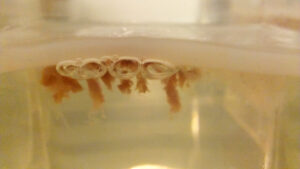We cleaned out our closets and brought all of our favorite video games from our childhoods. Come play all the classics! No RSVP necessary.
When: Tuesday, April 8 from 6 PM to 10 PM
Where: Hive76
Science Channel did a pretty cool piece on our research using sugar glass for making vascularized engineered tissues last year at Penn (thanks Randy for the sighting). Enjoy.
Thanks again to our co-workers at Penn, collaborators at MIT, and again to Hive76 and our awesome members who helped us get this research done!

PJ and a number of other Hive members have been fortunate enough to participate in preparations for the Drexel Design Futures Lab “Projects 12/13” exhibition. PJ was almost certainly the most involved Hive contributor — he helped with the development of a number of key software elements for several of the exhibits.

I wound up getting involved in the creation of a special display screen that was part of an interactive piece which allows people to “play” with a computer model of bacterial swarms. This piece was part of Tashia Tucker’s exhibit, and she wanted an “organic looking” display surface. After some brainstorming that included condemnations of the high price of silicone etc., PJ suggested bacterial cellulose. What!? The idea of a movie screen made by real bacteria to show movies of simulated bacteria was too “meta” to pass up.
I had grown some fairly large sheets of bacterial cellulose in the past, and was interested in having an excuse to grow something even larger — so sign me up! Tashia wanted a sheet that started out about 4’x8′ so that the final screen could be cropped to dimensions that were about the size of a slightly gigantic person.
Yikes — this was literally a tall order. Bacterial Cellulose (BC) is created by the same organisms that are used to ferment Kombucha — in fact, the “Shroom” or “Scoby” in a Kombucha culture is a big lump of cellulose. So this was simple, in principle, but the scale of the piece left a lot of novel details that had to be worked out.
Continue reading “Drexel Design Futures, Bacterial Cellulose (and a world record, maybe?)”
This Thursday, please join us at a FREE exhibition of the work of Cornelius Varley (1800-1860) put on by the venerable American Philosophical Society. It is a fantastic exploration of the life work of this fellow tinkerer and inventor who’s insight and explorations reminds me a lot of our Hive76 members!
A few of us will also be presenting at this event! We will have live 3D sugar glass printing, exhibitions of Brendan’s boom cases, Dan’s 8 mm RockBox, PJ’s electronics, Corrie’s textiles and artwork, Chris Terrell’s wood burning, and maybe a few more things.
We hope to see you there! Deets and directions below.
Deets:
Free Refreshments (wine, food, music) will be provided at the event!!
APS Requests your RSVP HERE: museum@amphilsoc.org
Thursday, June 6th, 2013
5:30-7:30 pm
APS Museum in Philosophical Hall
104 S. Fifth Street, Philadelphia, PA

On Thursday April 25, our series of events for Philly Tech Week continues as we open our doors for DIY Music Night (5pm-???). If you’re into music, making music, or making things that make music, you won’t want to miss it! If you’ve been to the space before, you’ll know that we run on a steady diet of tunes. And on Thursday, we’ll have all our audio and music-centric projects out in what is sure to be the loudest night of PTW. Come by and see the space, make some amplified noise, hang out, or share your own projects.
We’ll have guitars, amps, synthesizers, sequencers, speakers, fuzzboxes, tremolo pedals, signal generators, oscillators, speakers, drum machines, pickups, karaoke machines and probably alot more – all made at Hive76.
Plus we’ll have a handful of contact microphones to give away! We’ll help you turn anything into an amplified electric instrument in 10 minutes flat.
Hey everyone, as you may know, Philly Tech Week is coming up in late April. Hive76, as always likes to make ourselves as available possible during the week, and offer as much as we can. We’ll be open from 5pm-10pm Mon-Thur, and Noon-10pm on Saturday while showing off one unique and interesting aspect of what we do each day.Update: There’s no registration required for these events.

ZOMG GUYZ!
One of my first projects here at Hive76 was the Burning Zombie Dummy. A friend of mine had called me, asking me if I knew how to set people on fire safely, and that led into a very stern discussion about what he was trying to do and that I would take over so that noone would get hurt. So I became the Special Effects Design Engineer for Exile: The Family You Choose, and it was one of the best times of my life. I got to do some pretty awesome things (including making an impromptu harness for doing a shotgun-to-the-chest effect), met a lot of really great people, and learned a lot about a hobby that would ignite my passion in a way I hadn’t felt in a long time. Seeing our end result, this thing that we made together, from start to finish, without any adults (of course, we’re all adults, but you never really feel like it) helped to further cement my belief that anyone is capable of doing anything. The hacker spirit is strong in the indie film world. Continue reading “Zombie Web Series Kickstarter Time!”
Whoa! Fosscon is tomorrow and Hive76 is going to be there!!
What’s fosscon? From the fosscon crew:
Fosscon 2012 is a free and open source software conference, and will
include six general-interest talks, and workshops on topics including
development, community building, hackerspace activities, and more.
Learn about 3D printing, security, and protecting your privacy.
Network with the local tech community and discover new technologies.
Whoa, workshops?! That’s right! Some of which will be conducted by Hive76! We’ve actually been given an entire ROOM for the conference, so be sure to stop by when you’re there!
The workshops that we’ll be running cover Intro to soldering, Intro to Arduino, Build Your Own Flat Panel Speakers, and several workshops on Building Your Own Simple Square Wave Synthesizers.Several? Yeah, Sean will cover using 555 timers, MSP430s, and also Arduinos!
The costs for these workshops will vary from $10-$30 to cover instruction and also cost of materials used.
Make sure to register for fosscon! Seating is limited! If you’d like to financially support fosscon (you should, it’s awesome!), it will only cost you $25 and you get some nice swag! Otherwise, fosscon is a free-as-in-beer event, but you still have to register!
One of our core members, Jordan Miller, has just published a scientific paper using RepRap 3D printing technology to engineer living tissues for regenerative medicine. I’ll give you a rundown of the science and a step-by-step guide of how Jordan got to this great spot in his career. Jordan is quick to point out that this is work that would not have been possible 5 years ago, or without the help of RepRap, Hive76, and this wonderful city of Philadelphia.
There are other labs around the world that are attempting what Jordan and the rest of the team at UPenn and MIT have been working towards. The end goal of regenerative medicine research is engineered tissues and replacement organs for treatment of human disease. As Science news says,
Imagine a world where if your heart or kidneys failed, you wouldn’t have to endure an agonizing, possibly futile wait for a donor whose organ your body might reject. Instead, a doctor would simply take cells from your own body and use them to “grow” you a new organ.
Other lines of research are attempting to 3D print directly with living cells and gel. These so-called “bioprinting” approaches involve loading cells and gel in syringes to be used as feedstock to create a structure from scratch. The problem is that healthy liver cells, for example, usually die of starvation (lack of nutrients) and suffocation (lack of oxygen) while enduring the slow 3D printing process.

Enter Jordan and his innovation: since vasculature provides the lifeblood to resident cells, why not focus on the vasculature first?
Jordan and the rest of the research team at UPenn and MIT have developed a new way to create vasculature for living tissues. This 4 step process involves: 1) 3D printing a network of sugar filaments, 2) surrounding it with living cells in a gel, 3) dissolving away the sugar to leave behind a vascular network for 4) the delivery of nutrients and oxygen. He accomplished this with a custom built 3D printer, extruder and control software.
Here’s a step-by-step of Jordan’s many year process:
You can read the Penn press release about this awesome science, an overview from Science News, or the full paper. A more detailed post about the hardware used in this project will follow and soon you’ll be able to make your own sugar extruder. (It prints chocolate too!)